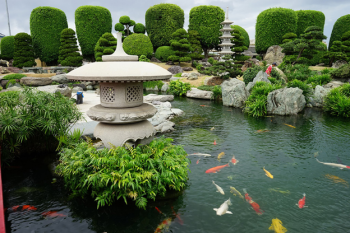
Causes of Koi fish discoloration
Koi fish can lose color due to a variety of causes, including:
· Stress
Koi fish are very sensitive to the aquatic environment and do not respond well to changes in the environment, which is also a common cause of stress in Koi fish. Fish can be stressed due to poor habitats such as unstable temperatures, unsafe water quality, insufficient lighting, and no shelter,... Stress can cause the fish to lose color or become pale.
· Disease
It's not natural that your fish suddenly loses color. Koi fish can be infected with diseases such as bacteria, viruses, fungi,... These diseases can cause the fish to lose color or appear spots on the body.
· Age
Koi fish as they age may gradually lose their colorful color and become more pale. So if your Koi has been with you for a while and starts to lose color, it may be part of the natural aging process.
· Genetics
Some Koi fish have a discoloration gene that is inherited from the parent's generation. As a result, the fry may have a lighter or no color.
· Diet
An insufficiently nutritious diet or not providing enough essential substances can cause Koi fish to lose color.
· Bright Environment Conditions:
When fish don't get enough light, their colors can fade and become faded. This can happen when the fish are raised in a low-light environment or an indoor aquarium. This is also a reason why Koi fish cannot fully promote the beauty of their colors
· pH and temperature concentrations are not guaranteed:
The ideal temperature of the Koi aquarium is between 20-270C and the pH concentration is around 7.0-8.5, if the readings are outside the norm is also a cause of your Koi fish fading.
How to fix discoloration in Koi fish
In order to prevent Koi fish from losing their color, it is necessary to ensure a good habitat for the fish, including clean water, stable temperature, sufficient light, proper diet, and regular health checks to detect and treat diseases in a timely manner.
· Water Quality Test
Make sure that water parameters such as pH, ammonia, oxygen are all within safe levels for Koi fish. You can use a water tester to ensure that they reach the right level.
· Provide adequate nutrition
Make sure that your Koi fish get enough nutrition from food. Use high-quality feed rich in fiber, vitamins and minerals. Youcan also use foods that enhance the color of Koi, but note that feeding of these foods needs to be controlled. Feeding your fish too much color-enhancing food will also harm your Koi's health.
· Ensure a comfortable living environment
To maintain the best color for fish, it is necessary to provide them with enough natural light or use appropriate artificial lighting.
Create a good habitat for Koi fish by maintaining the temperature and lighting in the aquarium accordingly. Set an effective filtration system to remove residues and create a fresh water environment.
· Reduce stress
Avoid situations that are stressful for Koi fish such as moving, changing the environment too quickly, or overloading fish in ponds. Provide a quiet and peaceful space for Koi fish.
· Treatment of diseases
If your Koi's discoloration is due to illness, learn about the symptoms and appropriate treatment. Sometimes, the use of medications or effective treatment of the disease can help correct discoloration.
· Proper care
Make sure that you take proper care of your Koi fish, including regular water changes, pond cleaning, and regular fish health checkups.
If after taking the above measures, the Koi still does not recover its color, you can contact Quhaku Koi Farm and consult with Koi fish farming experts for the best advice and treatment. Hopefully, the above sharing of Quhaku Koi Farm will help you in the process of raising Koi fish!





